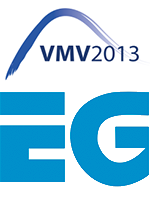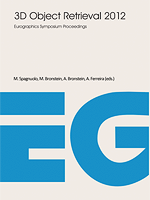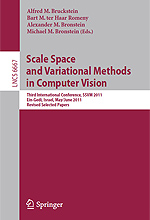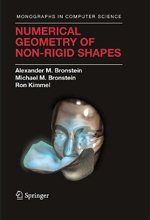| ||||||||||||||||||||

|
L. Agapito, M. M. Bronstein, C. Rother (Eds.),
Computer Vision - ECCV 2014 Workshops, Springer, 2015. ISBN: 978-3-319-16198-3. Abstract: The four-volume set LNCS 8925, 8926, 8927, and 8928 comprises the refereed post-proceedings of the Workshops that took place in conjunction with the 13th European Conference on Computer Vision, ECCV 2014, held in Zurich, Switzerland, in September 2014. The 203 workshop papers were carefully reviewed and selected for inclusion in the proceedings. They where presented at workshops with the following themes: where computer vision meets art; computer vision in vehicle technology; spontaneous facial behavior analysis; consumer depth cameras for computer vision; "chalearn" looking at people: pose, recovery, action/interaction, gesture recognition; video event categorization, tagging and retrieval towards big data; computer vision with local binary pattern variants; visual object tracking challenge; computer vision + ontology applies cross-disciplinary technologies; visual perception of affordance and functional visual primitives for scene analysis; graphical models in computer vision; light fields for computer vision; computer vision for road scene understanding and autonomous driving; soft biometrics; transferring and adapting source knowledge in computer vision; surveillance and re-identification; color and photometry in computer vision; assistive computer vision and robotics; computer vision problems in plant phenotyping; and non-rigid shape analysis and deformable image alignment. Additionally, a panel discussion on video segmentation is included. |
|||||||||||||||||||

|
M. M. Bronstein, J. M. Favre, K. Hormann (Eds.),
Eurographics Workshop on Vision, Modeling, and Visualization, Eurographics Association, 2013. ISBN: 978-3-905674-51-4. Abstract: These are the proceedings of the 18th annual Workshop on Vision, Modeling and Visualization (VMV 2013), which took place in Lugano, Switzerland, from September 11 to 13, 2013. Geometric and Visual Computing is one of the key research areas at the Faculty of Informatics at the Universita della Svizzera (USI) in Lugano, and we are glad to be given the chance to host this workshop and to welcome the scientific community. The VMV workshop is a unique event that brings together scientists and people interested in the interdisciplinary fields of computer vision and computer graphics, with special emphasis on the link between the disciplines. It offers researchers the opportunity to discuss a wide range of different topics within an open, international and interdisciplinary ambience, and it has done so successfully for a number of years. This year, we received 59 high-quality submissions from 12 countries, which were peer-reviewed in a double-blind review process by at least 3 reviewers from an International Programme Committee, consisting of 72 experts in the field. A total of 27 full papers was accepted for oral presentation and publication in the electronic conference proceedings. In addition, we accepted 7 posters for presentation and publication as an extended abstract. As in the last years, the VMV proceedings appear in the Eurographics digital library. The accepted papers were organized in six sessions: Visualization; Perception, Simulation, and Synthesis; Modelling; Medical Visualization and Applications; Vision; Rendering. In addition, we are happy that three internationally renowned experts have accepted our invitation to present keynote talks: Jamie Shotton (Microsoft Research, Cambridge), Olga Sorkine-Hornung (ETH Zčrich), and Hank Childs (University of Oregon and Lawrence Berkeley National Laboratory), each covering one of the three VMV core topics: Vision, Modeling, and Visualization. At the end of the workshop, a best paper award was announced, and the three best papers received an invitation to publish an extended version in a regular issue of Computer Graphics Forum. VMV 2013 was co-located with two events. On September 11, there was a meeting of the German Informatics Society Special Interest Group on Computer Graphics (GI-FB-GDV), and on September 13, a meeting of the Swiss Informatics Society Special Interest Group on Computer Graphics, Vision, and Visualization (SI-GRAVIS) took place. This workshop was sponsored by the Faculty of Informatics at USI, NVIDIA, the Swiss Informatics Society (SI), bbktech, and was organized in cooperation with the Eurographics Association. The contributions of these organizations are gratefully acknowledged.We further thank the Swiss National Supercomputing Centre (CSCS) for hosting theWelcome Apero on the first evening. A lot of work for such a conference occurs behind the scenes. Elisa Larghi, the general conference secretary, did a tremendous job in managing the local organization, and we thank Alessia Padovan for designing the conference artwork and Giacomo Toffetti Carughi for managing the conference webpage. Stefanie Behnke was, as always, in charge of the production of the proceedings and we are very grateful for her assistance with managing the submission system. Moreover, we thank our on-site volunteers at VMV 2013. |
|||||||||||||||||||

|
M. Spagnuolo, M. M. Bronstein, A. M. Bronstein, A. Ferreira (Eds.),
Eurographics Workshop on 3D Object Retrieval, Eurographics Association, 2012. ISBN: 978-3-905674-36-1. Abstract: This book contains the research work presented at fifth Eurographics Workshop on 3D Object Retrieval (3DOR) held in Cagliari, Italy on May 13, 2012. The 3DOR workshop series was started in Crete (2008), and then held in Munich (2009), Norrkoping (2010) and Llandudno (2011), always as a co-event of the Annual Conference of the European Association for Computer Graphics (Eurographics). All five such workshops are successful examples of international cooperation and the attendance demonstrates the relevance of focused topics. Demonstrating the increasing importance of the workshop, a record number of 23 papers were submitted this year. These papers were reviewed by an international Program Committee of 35 external experts in the area. Based on their recommendations, a selection of nine long papers was accepted for presentation at the workshop, giving an acceptance rate below 40%. Additionally, six poster presentations describing timely research results of high quality were included in the workshop program. Similarly to the previous editions of the 3DOR workshop, this year's event hosted the seventh Shape Retrieval Contest (SHREC'12). The goal of the contest is to evaluate the effectiveness of 3D-shape retrieval algorithms, thus playing an important role in the evolution of 3D Object Retrieval research. SHREC'12 contributes to the proceedings with four additional papers that detail the results of the competition. We are grateful to the Eurographics association for their support, and to all reviewers for ensuring a high quality program despite the tight schedule. Special thanks are also to Stefanie Behnke for her constant and timely attention. Finally, we hope that this workshop proves useful to all participants and sets the ground for long term interaction, collaboration and identification of future directions and potential problems in the field. |
|||||||||||||||||||

|
B. M. Bruckstein, B. ter haar Romeny, A. M. Bronstein, M. M. Bronstein (Eds.),
Scale Space and Variational Methods in Computer Vision, Lecture Notes in Computer Science (LNCS) No. 6667, Springer, 2012. ISBN: 978-3-642-24784-2. Abstract: The International Conference on Scale Space and Variational Methods in Computer Vision (SSVM 2011) is the third issue of the conference born in 2007 as the joint edition of the Scale-Space Conferences (since 1997, Utrecht) and the Workshop on Variational, Geometric, and Level set Methods (VLSM) that first took place in Vancouver in 2001. Previous issues in Ischia, Italy (2007) and Voss, Norway (2009) were very successful, materializing the hope of the first SSVM organizers, Prof. Sgallari, Murli and Paragios, that the conference would 'become a reference in the domain'. This year, SSVM was held in Kibbutz Ein-Gedi, Israel - a unique place on the shores of the Dead Sea, the global minimum on earth. Despite its small size, Israel plays an important role on the worldwide scientific arena, and in particular in the fields on computer vision and image processing. Following the tradition of the previous SSVM conferences, we invited outstanding scientists to give keynote presentations. This year, it was our pleasure to welcome Prof. Haim Brezis (Université Pierre et Marie Curie, France), Dr. Remco Duits, (Eindhoven University, The Netherlands), Prof. Stèphane Mallat (École Polytechnique, France), and Prof. Joachim Weickert (Saarland University, Germany). Additionally, we had six review lectures on topics of broad interest, given by experts in the field, Profs. Philip Rosenau (Tel Aviv University, Israel), Jing Yuan (University of Western Ontario, Canada), Patrizio Frosini (University of Bologna, Italy), Radu Horaud (INRIA, France), Gérard Medioni (University of Southern California, USA), and Elisabetta Carlini (La Sapienza, Italy). Out of 78 submitted papers, 24 were selected to be presented orally and 44 as posters. Over 100 people attended the conference, representing countries from all over the world, including Austria, China, France, Germany, Hong-Kong, Israel, Italy, Japan, Korea, the Netherlands, Norway, Singapore, Slovakia, Switzerland, Turkey, and USA. We would like to thank the authors for their contributions, the members of the Program Committee for their dedication and timely review process, and to Yana Katz and Boris Princ for local arrangements and organization without which this conference would not be possible. Finally, our special thanks to the Technion Department of Computer Science, HP Laboratories Israel, Haifa, Rafael Ltd., Israel, BBK Technologies Ltd., Israel, and the European Community's FP7 ERC/FIRST programs for their generous sponsorship. |
|||||||||||||||||||

|
A. M. Bronstein, M. M. Bronstein, R. Kimmel,
Numerical geometry of non-rigid shapes, Springer, 2008. ISBN: 978-0-387-73300-5. Abstract: Deformable objects are ubiquitous in the world surrounding us, on all levels from micro to macro. The need to study such shapes and model their behavior arises in a wide spectrum of applications, ranging from medicine to security. In recent years, non-rigid shapes have attracted a growing interest, which has led to rapid development of the field, where state-of-the-art results from very different sciences - theoretical and numerical geometry, optimization, linear algebra, graph theory, machine learning and computer graphics, to mention a few - are applied to find solutions. Numerical geometry of non-rigid shapes is the first attempt to consistently present nonrigid shape analysis, bringing together a variety of problems and approaches. The book gives an up-to-date overview of current state of science in the field. Self-contained presentation of topics unfolds systematically and numerous figures enrich the engaging exposition. Everyday examples are used to explain concepts and to illustrate different techniques. Practice problems follow the end of each chapter, with detailed solutions to selected problems in the appendix. The book will be of interest to graduate students, researchers and professionals in different fields of mathematics, computer science and engineering. It could be used for courses in computer vision, numerical geometry and geometric modeling and computer graphics or for self-study. Book website | Code | Tutorials | Data | Slides | Annotated bibliography |
|||||||||||||||||||
|
| ||||||||||||||||||||